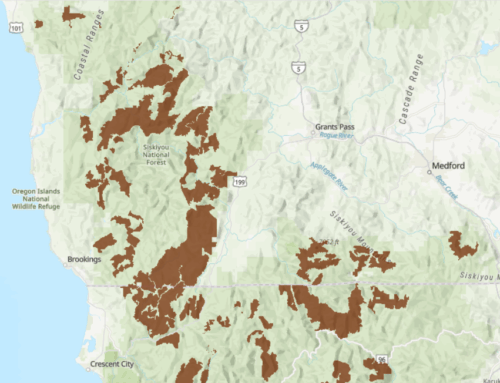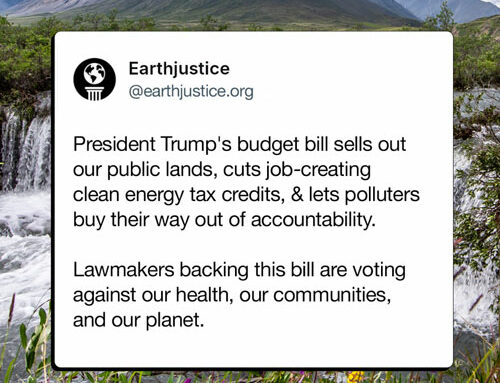The Conservation Column
By Pepper Trail
As I write this, Earth Day is just around the corner, so it seems an appropriate time to focus on a big-picture conservation issue: the importance of forests in the fight against the climate crisis. This recent overview is from the National Audubon Society.
Forests are Important in the Fight Against the Climate Crisis
Congress should pass a suite of policies that enhance the carbon storage and biodiversity of our forests.
Forests offer more than just beautiful scenery. They also protect drinking water, serve as stopover habitat for migratory birds like Hermit Warblers, and are an important piece in our defense against climate change.
As climate change worsens, forests will be increasingly vulnerable to drought, wildfire, pests, and disease, some cases of which have already become so severe that the forests lose the ability to naturally regenerate. In fact, the U.S. Forest Service (USFS) has at least 1.3 million acres of forests in need of restoration, but without adequate resources to ad-dress these needs, the risk of further destruction like mudslides and damaged infrastructure only increases.
Forests are also a key piece of the climate solution because they naturally store carbon dioxide in their trees, shrubs, and soils, and keep carbon emissions out of the atmosphere. Approximately one-third of the U.S. is forested, presenting huge potential for increased carbon storage through natural climate solutions—actions that protect and restore natural spaces while simultaneously reducing harmful emissions. We can help forests adapt to the changing climate while also drawing down carbon emissions, enhancing biodiversity, protecting our air and water, and creating new jobs.
Audubon’s own science shows that climate change is the greatest threat to North American birds, with two-thirds of species vulnerable to extinction if carbon emissions continue at their current pace. Birds that rely on boreal and western forests are at especially high risk. However, if we keep warming below 1.5 degrees C—which would require reaching net-zero greenhouse gas emissions by 2050—we can improve the outcomes for 76 percent of those imperiled birds. While reaching this target will require decarbonization across our electric, transportation, and industrial sectors, we can also implement policies that help our working lands be part of the climate solution.
This year, Audubon hopes to see Congress pass policies that can help improve the health and resilience of our forests, enhance bird habitat, and create jobs, including:
• Incentives for Forest Owners and Farmers to Adopt Climate-Smart Practices: To adopt climate-smart practices, private forest owners need financial resources and some protection from financial risk. Congress should consider new programs that provide direct payments, tax incentives, or easier access to voluntary carbon markets to re-ward landowners for climate-smart management practices. Any new programs must have proper safeguards that ensure the actions taken result in carbon storage that would not have happened otherwise. Programs must also value the health of the entire ecosystem over short-term gains, and should disqualify actions that result in clearcutting or illegal deforestation. Last Congress, the Trillion Trees and Natural Carbon Storage Act outlined a set of pro-grams that could help increase ‘net carbon stock’ on private and public lands, and the Growing Climate Solutions Act (GCSA) would provide needed structure to voluntary carbon markets.
The GCSA creates a program to certify technical assistance providers and third-party verifiers for the agriculture and forestry sectors for actions that reduce the amount of air and carbon pollution and for processes to naturally store carbon emissions. The legislation addresses barriers to entry for landowners trying to access carbon markets, and encourages practices guided by science, while also refining protocols that account for additionality, permanence, and leakage of practices. It also seeks to reduce barriers to entry for historically underserved, socially disadvantaged, and limited resource farmers, ranchers, and foresters.
The bill directs the U.S. Department of Agriculture to establish a set of nationwide protocols and standards that will help farmers, ranchers, and private forest landowners adopt sustainable management practices like planting cover crops, prescribed grazing, and reforestation. In addition to improving the health of working lands, these practices serve as natural solutions to reducing greenhouse gas pollution and increasing the amount of carbon stored in the soil. New protocols will improve the reliability and accessibility of voluntary carbon markets, but more action is need-ed to completely eliminate carbon pollution and address the impact on communities that have historically shouldered the burden.
“While the fight against climate change will require the broad participation of all sectors, agricultural stewards are a critical part of the solution,” said Greenberger. “The people who know the land best are the people that work it every day, and this bill presents sensible and bipartisan solutions to en-sure a cleaner environment for us all.”
• Restore National Forests: The USFS manages 193 million acres of forest lands, which includes at least 1.3 million acres in need of reforestation. These activities are paid for through the Reforestation Trust Fund (RTF), which only has dedicated resources to address a fraction of the backlog each year. Congress can help the USFS re-stock forests efficiently by removing the $30 million cap on the RTF and requiring USFS to develop a plan to address the backlog, both of which are included in the REPLANT Act. Reforestation should only be done with regionally appropriate species in areas that were historically forested, and in a way that enhances wildlife habitat.
• Invest in Urban Forestry: Urban trees and parks are vital to any city or town. Planting trees in urban areas can decrease air pollution, improve public health, increase access to green spaces, and provide important habitat for urban wildlife. Tree canopy can also provide shade and decrease the amount of energy needed to cool homes, which currently presents a disproportionate burden for low-income communities. Unfortunately, low-income communities have much lower rates of tree canopy cover, and don’t benefit as much from the cooling effects, flood protection, and reduced air pollution provided by urban trees. Congress can take action to in-crease resources for the maintenance of urban trees and forests through programs like the Urban and Community Forestry Program.
•Protect Old-Growth Forests: Old-growth forests comprise less than seven percent of all U.S. forests but have out-sized importance for wildlife habitat and carbon storage. Old-growth stands in the Tongass National Forest in south-east Alaska store considerably more carbon than younger parts of the forests, both in their trees and deep soils. Congress should protect these remaining stands by not opening them up to new logging.
•Invest in Research and Development: There is still much we don’t know about how our forests can be part of the climate solution. Congress can support scientific inquiry into forestry by increasing funding for relevant re-search—such as the Forest Inventory and Analysis program—and to entities that can help provide regional expertise, like land-grant institutions.
Efforts like these are absolutely essential to slow the headlong momentum of the climate crisis. As we head into another hot and very, very dry summer, we are all acutely aware of the peril that climate change poses to the forests that surround us. Those forests provide water, wildlife habitat, recreational opportunities, and countless other services to the region. We must save them, so they can save us.



Leave A Comment
You must be logged in to post a comment.